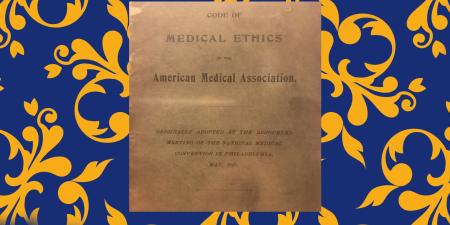In an ideal world, physicians and patients would be able to make treatment choices in patients’ best interest without having to consider extraneous factors, but that is far from the way medicine is practiced in this day and age. Instead, physicians must operate within a scheme of regulations imposed by numerous third parties that impose a host of constraints, ranging from what physicians can say to what medical procedures they must perform. This past November, the DEA published a long-anticipated notice of proposed rulemaking that seeks to schedule the drug Tramadol [1]. This notice came with little fanfare in the medical community and, like most such decisions, went almost entirely unnoticed by medical students. It is easy to wonder why medical students would care about such a technical and minor government action, but it does matter. Many free student-run clinics, including ours at the University of Florida, have adopted voluntary policies of not prescribing controlled substances. For clinics like these, Tramadol, a currently unscheduled prescription painkiller, has been a mainstay in treating patients with refractive pain. With this decision to schedule Tramadol, we need to be prepared to replace one of our most relied-on tools. That is not to say that Tramadol should not be scheduled, but merely that these things matter to medical professionals, students included.
This issue of Virtual Mentor explores the various ways third parties, be they legislators, government agencies, or nongovernmental organizations, affect how physicians are able to care for their patients and the ethical dilemmas that arise when these rules are at odds with how we may prefer to act.
Regulations that affect the physician-patient relationship can be broadly grouped into three categories: those that compel or restrict actions during patient encounters, those that affect access to drugs, and those that carve out the rights of patients.
The first category is that in which the most obvious ethical dilemmas arise. Bahareh Keith, DO, and Kimberly B. Handley, MSW, LCSW, discuss how to navigate mandatory reporting statutes, such as those that govern child abuse, in the context of an asthmatic child repeatedly exposed to secondhand smoke, a situation which touches but does not necessarily cross the line of child abuse. In a second case commentary, Jen Russo, MD, MPH, explores the conflicts between ethical medical practice and laws that require doctors to show an ultrasound to a woman before proceeding with an abortion. This issue is particularly timely; it was just a few weeks ago that a federal judge struck down a North Carolina statute that went one step further, requiring physicians to describe the results of the mandatory ultrasound to patients in addition to requiring them to show it [2]. Jody Steinauer, MD, MAS, and Carolyn Sufrin, MD, MA, further discuss legislative interference with abortion provision, including the problems caused for patients by legally protected conscientious refusals to refer them for abortion care.
On the flip side of mandatory actions are prohibited actions. Mobeen H. Rathore, MD, CPE, discusses gag laws that prohibit physicians’ asking patients about gun ownership. This law thwarts our ability to protect children by promoting gun safety at home. At the same time, it forces us to contemplate the nonmedical rights of our patients.
The second category concerns the effects of third-party decisions on the access our patients have to essential drugs. When third parties make rules restricting drug use or artificially inflate prices to astronomical levels, our patients’ access to necessary drugs is severely curtailed. Susan Wood, PhD, recounts the Food and Drug Administration’s abnormal handling of the application to sell emergency contraception over the counter, which obstructed appropriate access to levonorgestrel for over a decade for what appeared to be politically motivated rather than scientific reasons. Gary M. Reisfield, MD, explains how the FDA’s decision to withdraw approval for generic versions of OxyContin after approving a new abuse-deterring formula, OxyContin OP, has delayed the long-anticipated appearance of cheaper generic versions of the drug.
On the other hand, when access to drugs is expanded, our patients stand to benefit greatly and our ability to fulfill our obligation to care is enhanced. In the podcast, Gary Wang, MD, PhD, discusses how the FDA’s expanded indications for Truvada granted our patients improved access to the drug and allowed physicians to serve our HIV-positive patients better. It is a telling example of how a simple regulatory move regarding a drug that was already on the market was able to improve patient care. In her case commentary, Ly Le Tran, MD, JD, explores the arguments for and against accepting free samples from pharmaceutical companies to dispense to patients, in the context of the Sunshine Act, designed to make relationships between physicians and the pharmaceutical industry more transparent. An excerpt from the AMA Code of Medical Ethics takes up questions of drug-related cost containment and physicians’ relationships with industry.
Finally, this issue tackles the subject of protections for patients. Collin O’Neil, PhD, examines the ethical implications of proposed changes to the Common Rule that would allow doctors to conduct certain forms of low-risk research on their patients without patient consent. He concludes that such research cannot be done ethically without the explicit consent of the participants. Another excerpt from the AMA Code of Medical Ethics discusses physicians’ participation in clinical trials and the avoidance of related conflicts of interest. William D. White, PhD, reviews the concepts underlying mixed self- and third-party regulation in medicine and the concerns raised by some critics about whether self-regulation is sufficient to protect patients’ and society’s interests. Lauren B. Solberg, JD, MTS, introduces online medical communities, membership in which can pose certain privacy risks that are only partly mitigated by legal protections against health-based discrimination.
Third-party decisions influence everything physicians do, from the mundane activities of daily practice to the most innovative advances our field is making. It is my hope that this issue illustrates the important issues that arise when medicine interacts with third parties and that it will encourage medical students and physicians to stay abreast of these topics as they continue their careers.
References
-
Palmer KL. DEA publishes long-anticipated proposed rulemaking proposing to place Tramadol in Schedule IV. FDA Law Blog: Hyman Phelps & McNamara, PC.http://www.fdalawblog.net/fda_law_blog_hyman_phelps/2013/11/deas-publishes-long-anticipated-proposed-rulemaking-proposing-to-place-tramadol-in-schedule-iv.html. Accessed February 28, 2014.
-
Mungin L, Sutton J. Judge strikes down North Carolina ultrasound abortion law. CNN. January 19, 2014. http://www.cnn.com/2014/01/18/justice/north-carolina-abortion-law/. Accessed February 28, 2014.



